Jade River: A History of the Mahurangi
Ronald H LockerFirst published 2001. Published online 2014–. This online edition is a work in progress…
Pages 134–139in printed edition
Darrach and sons of Prince Edward Island
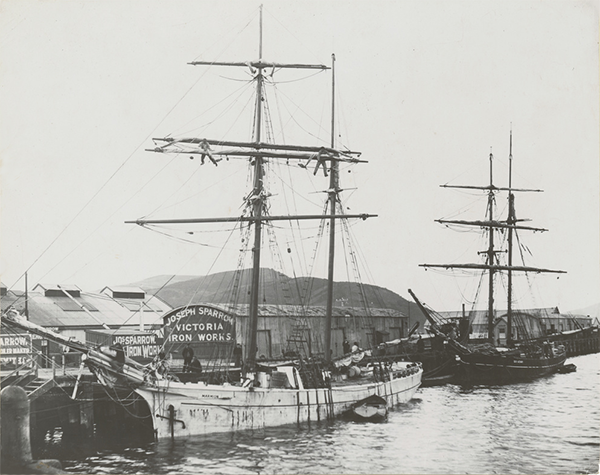
Not Darrach’s Darnedest by Half: Topsail schooner Marmion, at 92 tons, was a little less than half the measurement the Ethel attributed to Darrach and Sons the following year, and her sister brigantine Ada C Owen, two years after that. The Ethel and Ada C Owen, were similar in scale to the brig Pākehā, aboard which the Darrachs emigrated to Aotearoa. photographer David De Maus
Prince Edward Island, the smallest province of Canada, is possibly best known as the site of the novel Anne of Green Gablesscrumptiously ironically, given the insistence of the eponymous principal character that her name be spelt with an E, published 2001: “Ann of Green Gables”. It lies within the Gulf of Saint Lawrence, off Nova Scotia, of which it is not part. It was from the adjacent Cape Breton Island, part of Nova Scotia, that the Waipū folk had migrated, the first arriving in Auckland in 1853.
There had been a previous migration from Prince Edward Island. In 1858, the Prince Edward had brought a company to Auckland. The inducement was the free land grant programme of the Provincial Government, attractive to large families who had no hope of finding farms for all their sons on the island. These folk had sent back favourable reports. Some, such as Thomas Williams and George Owen, had already established themselves as merchants in the city. Thomas Williams, now sailmaker and ship chandler of Auckland, decided to order a vessel from his old home. So the brig Pākehā of 173 tons came to be launched from the yard of Robert Orr at New Glasgow, Prince Edward Island, on 24 October 1863. The price was £2000.
A second migration was planned to utilise the delivery voyage: four families and six single men, 33 in all, besides the crew. The families of the close friends, John Darrach and George Bagnall, were among them.
John Darrach was born at Cove Head on the Island in 1817. He was the son of Malcolm, who at 21 had migrated from Colonsay in 1806 with his father Angus—a farmer—and family. The line went back at least five generations in that place. In 1847 John married Elizabeth Semple, daughter of a local farmer, James Semple, and Mary née Inglis. The builder of Pākehā, Robert Orr had also married a daughter of James Semple, and so Darrach and Orr were brothers-in-law, and neighbours. John may well have come to New GlasgowThis village should not be confused with the substantial town of New Glasgow, just opposite, on the mainland of Nova Scotia to learn his trade in the Orr shipyard. In the year of his marriage, John bought 88 acres a little down river, and there built a home and shipyard. It was then a busy place with good timber, a deep river, and two forges, each with 10–12 men hammering out ship fittings. John built ships for the immigrant traffic, sailing in them to England to sell—as did James Meiklejohn. It is said that his main reason for leaving was that the heyday of this shipbuilding had passed. In the period 1800–1880, thousands of ships were built on the island. No doubt this and farming had taken its toll of the timber. It is also claimed that a warmer climate was advised for his wife’s health.
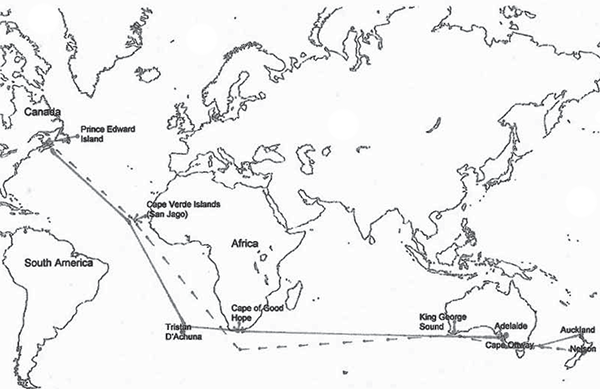
Changes in Latitude: When John Darrach and his family of eight left annually icebound Prince Edward Island for Aotearoa aboard the brig Pākehā, they were bound for a much balmier island, even if the soil of their farm adjoining their new, Mahurangi, shipyard was too heavy for potatoes. Solid line is the passage sailed by the Pākehā. That dotted, was sailed by the Lady Grey on an earlier voyage, when the Pākehā’s first mate, James Robinson, first visited New Zealand. James’ sister Catherine was maid to Elizabeth Darrach—whose son delivered en route survived only 12 days—providing additional justification for displaying this map of Robinson’s of two Prince Edward Island – Aotearoa voyages. image Master Mariner – Captain James Robinson
On 5 December 1863, John Darrach paid Charles Bell, merchant and tailor, and purser for the voyage of Pākehā, for five passages at £24 each for his family. His six Prince Edward Island-born childrenas published 2001: six children were, in chronological order, 1848–1861: Malcolm, James, William, Duncan, Elizabeth, and Janet Annas published: Janet. Several sources render the then youngest daughter’s name Jenny Ann.
Darrach, Bagnall and their eldest sons were all members of the local division of the Sons of Temperance. Their fellows presented them with an address of regard and good wishes “as you are about to leave these shores, and it may be for ever”. In reply John said:
We are fully aware of the responsibility resting on us as heads of families, in leaving our present home, but believing as we do that the Colony we have chosen is much superior to this in climate, mineral wealth, and otherwise, we trust that emigrating thereto, if not a benefit to ourselves, will prove a benefit to our families. — our future home is an appendage of our Mother Country, and wherever Britain reigns, protection and liberty is afforded to those who conduct themselves in an upright and becoming manner. — although our house will be on the mighty deep, and our little barque riding on the crest of the angry wave — we are under the protection of Him who rides on the wings of the wind, and holds the seas in the hollow of His hand. And when arrived safely, we may still worship the God of our fathers—.
The brig was moved out, and aroundas published 2001: ship was moved out into Charlottetown Harbour to avoid being frozen in, and sailed on the day before Christmas Eve. The voyage to Cape Town was uneventful, although not for Elizabeth Darrach. Her delicate health survived giving birth at sea near the Equator to a son, named Alexander Campbell after the captain. The babe died 12 days later. John’s view of the captain had changed by the last half of the voyage: they almost came to blows over the treatment and provisioning of the passengers. On the eve of departure from Cape Town, the ship was saved from destruction by Mrs Bagnall’s timely warning, as a large barque, dragging its anchor, bore down on the little brig. The second mate’s swift action in chopping the bow hawser reduced the impact, confining damage to loss of the bowsprit and a battered stem, which took three weeks to repair. After a stormy passage south of Australia, the ship arrived in the Waitematā Harbour exactly five months after departure.
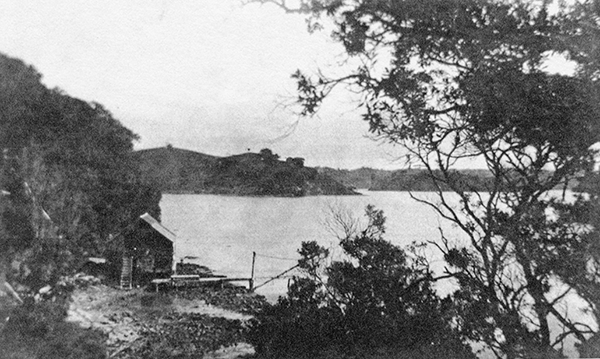
Belying Busiest Boatyard: John Darrach and Sons’ unprepossessing yard, in Te Kapa, that produced the biggest tonnage of cutters, brigantines, schooners and topsail schooners in Mahurangi—more than three times that of the Darrochs. The size of the vessels launched here—the largest being the 183-ton, 99-foot brigantine Ada C Owen—came closest of the Mahurangi boatyards to being in the league of shipyard. Sedimentation precipitated by the deforestation resulting from timber extraction and pasture creation would have prevented vessels of the displacement build by the Darrachs being launched from the site of their yard, long since. image Jade River: A History of the Mahurangi
The brig was handed over to her owner, Thomas Williams. The purser, Charles Bell, became his trading partner in Auckland until they fell out, and Bell went to the Waikato. The captain went into the service of J. J. Craig. The ship, while engaged in the timber-grain trade in 1881, eventually went ashore near Lake Ellesmere, drowning all but one of her crew.
The new arrivals found accommodation at a premium. Families taking refuge from the Waikato war had crowded into the capital. The immigrants’ barracks had to be the first haven, then a house in Wellesley Street. The two families were left there while Darrach and Bagnall went exploring for a site for a shipyard. A bay was chosen just inside the western Matakana Heads and the land was leased from James Buchanan. The site was known as Horseshoe Bay—later Bagnalls Bay—and is the next above Brick Bay. Howie and McKay had built craft there before them. While the Bagnalls set about building houses for the families, the Darrachs got the shipbuilding under way. By the end of 1864, both families had come up in Glance and were installed. Bagnalls had no experience at shipbuilding, but George and his eldest sons, Lemuel and William, learned fast under the expert tutelage of John Darrach. Workers were also hired. Two schooners, Black Hawk and Excelsior, were built by the partners before they separated: Darrachs to Te Kapa; Bagnalls, after a vessel on their own account, to Thames.
In 1866 John McGechie, a pioneer settler in Te Kapa, sold his 216 acres (Lots 120,126) and homestead Rosebank to Darrach, and moved to a farm in Papatoetoe. The Darrachs took over in December 1866. A last child, Sarah, had been born at Matakana that year.
In a letter home, to David Stewart of Charlottetown, 6 June 1870, John told of parting with Bagnall, and taking up a new life on the Mahurangi as farmer and shipbuilder:
For my own part I have not been ill since my arrival. Our friend Mr Bagnall and family, as I can hear all well. Both boys still hang about the old man. They live on the Thames Goldfields, but so far their claims have turned out nothing, they live altogether on wages, building houses and so on. Neither of us had much when we arrived, we worked together for 2H years, built two vessels and sold them, times were poor, we made nothing. Lemuel and myself disagreed, then we parted. I moved from Matakana to Mahurangi, four miles – agreed for a farm, a fine place of 230 acres – the river or bay on one side, the sea on the other, plenty of kelp and the land first class for grass; too heavy for potatoes. We have tried wheat, it grows well, some as high as 40 B to the acre. Flour here is only worth £12–14. Keeping cattle pays better, no trouble with them. We have 18 head and soon will have a large stock. One of the worst drawbacks is the want of a little keen frost to destroy the grubs and ground briskets.
My boys are all with me. Our principal work is Ship Building. The oldest boys are first class hands. Besides our own four sons we have five boys apprentices, do all our own work from keel to truck. We have built since leaving Bagnall: Cleopatra 92 tons. Sold for £1650 Stg; Flirt 99 tons for a Batch of Nova Scotians. Hull and spars for £1100 Stg; Laetitia Schooner 45 tons ready for sea £950. We are in town with her now and will leave for Home tomorrow to commence again. We live 28 miles from Auckland by water, can go or come almost any day in the week. I have come up in four hours, cost 5/.
We have first-class natives—no disturbances north of Auckland since we came—old residents have been very kind, I have many good friends in Auckland who assist us along, George Owen amongst them. He keeps a large grocer’s shop and has done remarkably well. All my family are well and in good spirits and although sometimes hard pushed I do not regret coming here. There are drawbacks like other places. We have made but small progress so far but what we have done is sure.
If any of my brothers or friends wants my address it is:
John Darrach, RoseBank, Mahurangi, New Zealand.
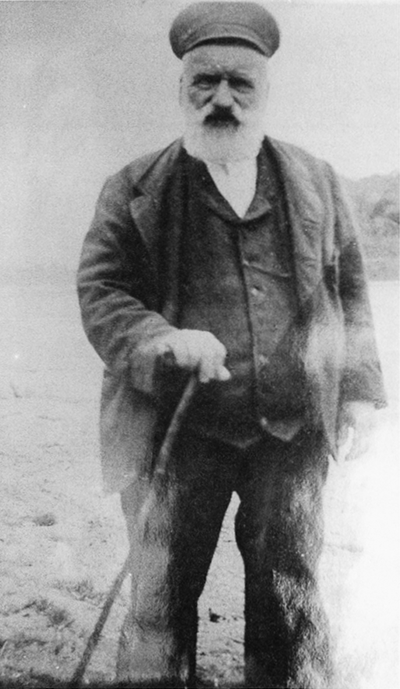
Patron of the Mahurangi Heads West School: As chairman of Mahurangi Heads District School, at Schoolhouse Bay, Scotts Landing, John Darrach, in his late 60s, wrote repeatedly to the Board of Education, urging the establishment of a school at Mahurangi West, concerned of the danger to the pupils rowing across the Mahurangi Harbour to his school. He reported that there were 23 Māori and 14 European children between the ages of 5 and 15 who would benefit from a school at Mahurangi West. image Warkworth Museum
Darrach became the most successful shipbuilder on the Mahurangi, specialising in schooners and brigantines. His four sons, as he said, all worked with him, as Darrach & Sons. The labour force was surprisingly small for the output in 1870 (a ship a year): five apprentices besides themselves.
The boys did not all stay in shipbuilding. Duncan went into engineering and was involved in the building of the breakwater at New Plymouth. William became a builder then a farmer.
By 1876, the eldest son, Malcolm, had set up his own slipway nearby, at Condons Point on the other side of Poplar Bay. There he built a schooner, a cutter and a brigantine. In 1878 he moved to Devonport where he started his last ship, Handa Isle. But he fell out with his partner, the well-known builder John Bigelow, who completed it in 1881. Malcolm left for Fiji, then moved to Australia, where he owned a canvas goods business and finally, moving with the times, became a car trimmer.
The Borealis was the last ship to be built on the Mahurangi. The agreement to build her survives, giving an interesting insight into yard procedures. It is written on a mere two sheets of foolscap, and is a very loose specification indeed. After a preface in legalese, H. F. Anderson, ships chandler, and K. McKenzie, master mariner, agreed on 10 December 1878 with John Darrach and Sons:
to build hull and spars complete of schooner of the dimensions: 82′ on the keel, 25′ of beam, 10’4″ depth of hold — to be built of the best timber the Province can provide, the hardwood to be Pohutukawa and the softwood to be best heart of kauri and to be finished in the usual style of J D & S — they finding the same fixing as for other vessels they have built for H F A & Co. The vessel to be finished and afloat within 12 months.
The owners agreed to pay:
the sum of £1500 for the hull and spars complete — £100 when the keel is laid. £200 when in frame. £400 when planked. £400 when the deck is laid, and the remaining portion when she is finished and delivered in Auckland.
The builders are to furnish the owners:
…with a full and complete list of all castings and blacksmith work to enable them to procure those fixings in due time for the finishing — J D & S to fit and fix them in place — the vessel is to be built under the inspection of Capt. H F Anderson, marine surveyor, so as to Class A1 in Germanic Lloyd for ten years.
Here the builders had to work under the eagle eye of an owner-surveyor, but clearly with a good deal of mutual trust. The ship was launched on schedule in December 1879 in time to take part in the Auckland Regatta of the following month, where it finished fourth.
The owners of the Borealis were an interesting partnership, both original migrants to Waipū. Hugh Anderson, former ship’s officer, had married the daughter of leader, Norman McLeod, who was a vehement opponent of whisky. Captain Kenneth “Omaha” McKenzie was an accomplished smuggler of spirits from New Caledonia. He took the Borealis on a disastrous maiden voyage, “blackbirding”—a euphemism for non-chattel-slave tradingas published: “blackbirding” (Indentured labour from Melanesia to Australia and Fiji).
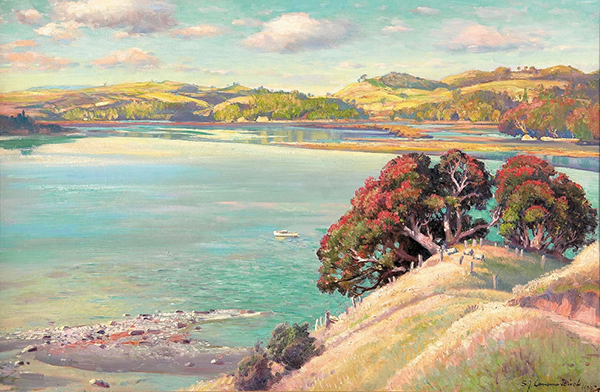
Darrach Side of Te Kapa: Long after the caulking hammers rang on its eastern shoreline, Samuel Birch’s The Pōhutukawa Tree captured a quiet summer’s day in Te Kapa. Styled “Lamorna” from the Cornish cove favoured by he and fellow artists, Samuel John Birch also once stayed a cup-of-tea distant from where his easel stood here in 1937. Apparently labelled “The Pohutukawa Tree, Dairy Bay, Mahurangi Heads”, Dairy Bay is in fact 1.7 kilometres due south, behind the artist, past four bays along Mahurangi Peninsula, from this vantage. Darrach and Sons shipyard was on the now impossibly shallow shoreline at the foot of the Pōhutukawa festooned headland in the midground. Darrochs built on the opposite, western shore. oil on canvas Samuel John Lamorna Birch
The lines of the ship were determined by building a half-model, fashioned to what the builder’s experienced eye told him was right. The shapes of the frames were then laid off from this model. Darrach’s model for his brigantine Flirt survives in the maritime section of the Auckland Museum, a very elegant object in highly polished kauri. Ron Vine picked up one of these half-models from the mud of Lagoon Bay, when he lived there. Molly Wynyard told me that there were several of these treasures lying in a shed at Rosebank when her father, James Shore, took over in 1929. Their fate is unknown, but perhaps someone cherishes them still. The pitsaws, unwanted in the clearing sale four years earlier, were then rusting away beneath the cliff.
Darrach’s timber was cut during the winter, and four months were allowed for the planking to season. It has been claimed that the Darrachs were their own sawyers, although milled timber was available in Auckland. Brown’s water-powered mill at Warkworth, 1844, probably closed about the time Darrachs were getting into their stride. It seems likely that when they reached their amazing peak of four ships per year, 1873–4, they would have been buying in sawn timber. It was probably normal practice to procure the ship’s hardware from the foundries and smithies of the city. The rigging could also be bought there. James Robertson had established a ropewalk on Parnell Rise by 1843, buying his harakekeharakeke, Phormium tenax, New Zealand flax from settlers’ wives, and later from Māori. The cutter Sea Belle brought a cargo into the Mahurangi in 1863, containing 22 tons of chain, spun yarn for caulking, and a bale of felt for laying under the copper sheathing.
Darrach chose his site well: a wisp of sand below his home, confined between sandstone shelves, unusually smooth and level. Beyond the mud drops steeply to the channelit is difficult to resolve this description with the shallow estuarine bathymetry when Dr Ronald Locker wrote this, circa 1990. There was ample room to set up four ships on a near perfect working surface. Fragments of copper, iron and glass lie about. There I picked up two large ringbolts and the offcut of a pōhutukawa rib. The present owner has a great collection of glassware from the site. Masses of rusting iron protrude from an eroding bank. There, I am told, the bank fell down on his derelict building shed, burying its contents. A poor photograph survives of this decaying shed, already partly unclad, and its jetty. It is sad to admit that this is the nearest I can find to a photographic memoir of the great shipbuilding days of Mahurangi. Cameras have been around in New Zealand since the 1850s and there are many photographs of the 1860s. (I have seen two of the Sandspit in 1863). Photography was common enough when Darrach built the last ship in 1880. Somewhere, in someone’s archive, there must surely be a photo of the Mahurangi shipbuilders at work!
The list of ships built (see appendix) leaves no doubt that Darrach and Sons were the leading shipbuilders on the Mahurangi, indeed there would be few other yards in New Zealand that could turn out eight large vessels in two years, as this one did in 1873–4. The family total was three cutters, 12 schooners, 10 brigantines or topsail schooners, and a barquentine. The brigantine Ada C Owen was the largest ship built on the Mahurangi. The Ethel was almost as large. The barquentine Handa Isle, begun by Malcolm Darrach at Devonport, at 275 tons, was a much larger vessel again.
John must have had little time to devote to farming. However, the farm long outlived the shipbuilding, and finally extended to 670 acres, still without a road access. It was the third son, William, who became the farmer. His widower father lived on there in retirement, until his death in 1897.
William had gone south and built railway stations on the main trunk line. In 1890 he married Ada Mason of Devonport and began a family there. About 1894 he returned and took over Rosebank. There were three sons and three daughters. Agnes married Llewellyn Parry. Hugh married Gladys Jamieson, and so became my uncle. He worked for most of his life as a seaman for Parry Brothers.
Rosebank was sold in 1925, and has passed through several hands. John Shore, who bought it in 1929, extended the house and added verandas. His daughter Molly, married neighbour Ted Wynyard, who worked for her father. Shore died after nine years and the farm was sold. The house was demolished in 1943 and the materials reused in a house at Martins Bay. All that remains on the headland northeast of Poplar Bay, are remnants of foundations, a Norfolk Island pine, bulbs run wild and old fruit trees. In that peaceful place, it is hard to conjure up the busy ring of hammers in the bay below.
The king of the Mahurangi shipbuilders lies with his wife beneath a headstone in the Mahurangi East cemetery:
John Darrach 1817-1897 Elizabeth Darrach 1826–1876
Arrived in NZ from Prince Edward Island 1864
A long journey, intended to save her health from the harsh winters; the colony gave her twelve more years—John reached fourscore.

Great piece on the Darrach family. Hugh Darrach and Gladys Jamieson were my dad Neil Darrach’s parents. We lived at Mahurangi many years when I was young.
Wonderful to receive your comment Kim. Sarah and I lived in two houses at Mahurangi West that you lived in, the last being in Huawai Bay, which is where we met the author of this history Ronald Locker, and his sister, on one of their visits to the place where they had spent so many school holidays.
Good history. I believe Hugh and Gladys were my great-grandparents—their son Roy was my grandfather.